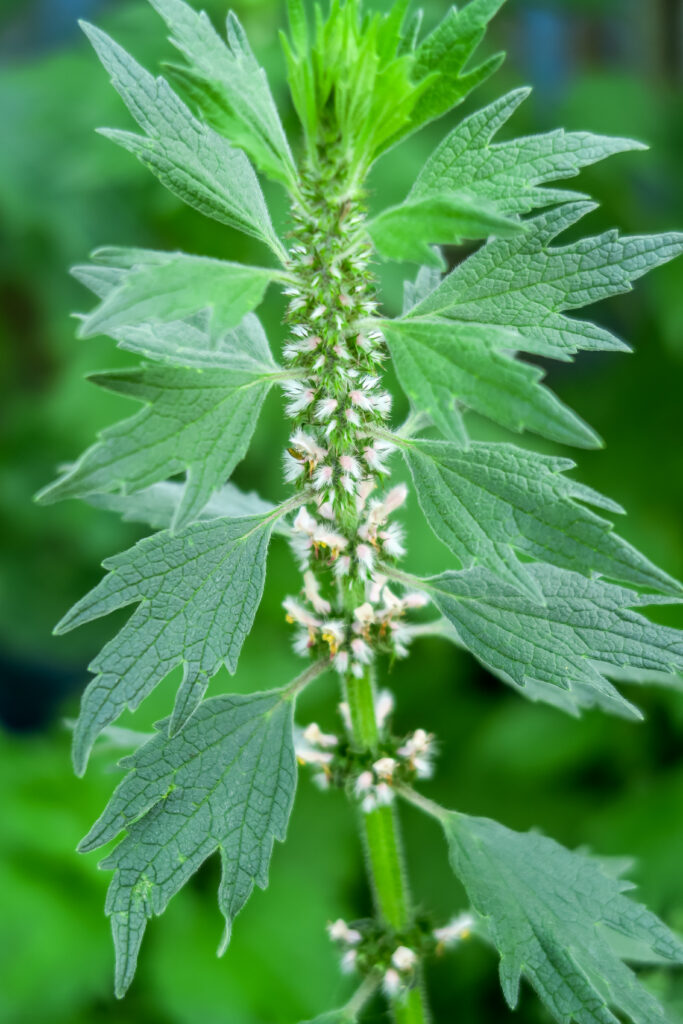At the intersection of tradition and botanical wonder lies Motherwort, scientifically known as Leonurus cardiaca. This perennial herb, belonging to the mint family, has long been heralded for its nurturing and healing capabilities. With a history steeped in both myth and medicine, Motherwort offers more than just botanical splendor; it serves as a stalwart guide through the emotional and physical trials of life. As we delve deeper into the details of Motherwort’s story, we uncover layers of wisdom and healing embedded in its very being, capable of transforming lives, fostering resilience, and nurturing the deepest parts of our souls.



The medicinal heritage of Motherwort traces back to ancient times when it was referenced in old herbal texts as a remedy for hysteria—a term now considered outdated and recognizing the misinterpretation and stigmatization of women’s mental health. In these times, hysteria was attributed to an imbalance within the body that was misunderstood and often trivialized as overly dramatic behavior. This has since evolved to appreciate the complex layers of emotional health, vindicating plants like Motherwort that address these dimensions with grace and efficacy. In this vein, Motherwort’s essence speaks to the heart, nurturing emotional well-being and bringing a sense of calm to turbulent inner waters.
At the heart of the tale is a woman burdened by loss and grief who turns to Motherwort for solace. With each soothing sip of Motherwort tea, she feels her frazzled nerves calm and her mind begin to find peace. The world, once overwhelming, begins to breathe with a newfound sense of humor and whimsicality. Her perspective shifts from one of internal chaos to a gentle appreciation for the quirks of life, leading her to discover joy in small, overlooked places. This transformation extends into her interactions with others, where she finds her own pain as a bridge to connect with others, sharing humor and hope as healing agents.
Motherwort’s story is not just one of magical transformation but one rooted in enduring companionship. It is a friend to many, offering comfort as a medicine for emotional and physical wounds. Whether treading through waves of grief or the storms of change, Motherwort is ever-present, lending a calming hand and a whisper that amidst adversity, growth and renewal await. In my gardens in Ecuador, she reseeds herself in a dense mat that can often be turned into the soil for biomass.
Motherwort’s name, “Leonurus cardiaca,” meaning “lion heart,” captures the essence of its powerful association with courage and resilience—echoing its properties as both a heart tonic and a womb healer. The European variant’s historical moniker, “motherwort” (wort meaning medicinal herb), affirms its role as a maternal figure in herbal medicine: aiding mothers through childbirth, soothing the heart, and offering emotional refuge. This bond extends across cultures as seen in Chinese medicine, where Motherwort (known as yimucao) is a staple of postpartum care, highlighting its universal appeal and healing capacity.
In Western traditions, Motherwort has established itself as a trusted companion during hormonal shifts and periods of emotional turbulence. The herb possesses uterine tonic properties, assisting with menstrual irregularities, painful cramps, and menopause-related discomfort. Its ability to foster emotional calm is equally noted, supporting those grappling with anxiety, stress, and disturbances rooted in the heart.
Its soothing capabilities on the nervous system bring Motherwort into domains of mental health, where it is leveraged for alleviating tension, anxiety, and stress-induced conditions. Its constituent, leonurine, is under investigation for potential cardiovascular benefits, potentially promoting heart health, improving circulation, and influencing blood pressure regulation. Exciting avenues open for those merging traditional practices with contemporary insights—a reminder of the vitality contained within this humble herb.
As with many plants in the mint family, Motherwort shares its unique signature of square stems, deeply lobed serrated leaves, and small tubular pink to purple flowers nestled in densely whorled spikes, standing resilient against the elements. A distinct aroma emerges when its leaves are crushed, invitingly described as a cross between citrus and mint. For the experienced herbal hand or curious novice, these characteristics guide identification and cultivation.
The practice of making tinctures from Motherwort accentuates its dynamic potency—harnessing its alcohol-soluble components to address emotional unease and improve heart function. Whether employed for calming the fraught mind or revitalizing an anxious heart, Motherwort tinctures remain a cornerstone of herbal preparations, lax in neither efficacy nor tradition.
In gardens, Motherwort’s seemingly tenacious nature is revealed in its vigorous self-propagation and adaptability. While some might view its prolific spread as a challenge, many embrace its vibrant presence as a testament to the plant’s resilience and fortitude. As Motherwort blooms, its flower heads transform into charming, spiky little nests, adding unique texture to the garden and providing safe havens for pollinators. By welcoming Motherwort into the landscape, gardeners attract bees and other beneficial pollinators, allowing this robust herb to contribute to the thriving tapestry of ecological harmony.
Interestingly, Motherwort shares a beneficial relationship with Aspergillus niger, a fungus capable of breaking down organic matter and enhancing nutrient availability. Together, they form a remarkable partnership that supports Motherwort’s resilience against environmental stressors, yielding enhancements in growth and the bioactive compounds integral to its medicinal use. By fostering this partnership, through methods such as applying nutrient-infused teas, one can cultivate not only a robust plant but one tidily harnessing its full therapeutic potential.
Motherwort Elixir Recipe
To craft an elixir, communing the calm and warmth of Motherwort with other peaceful herbs, this recipe serves as a beacon of emotional well-being.
Ingredients:
- 1/2 cup dried Motherwort leaves and flowers
- 1 tablespoon dried hibiscus, rose, or lavender petals (you could also add lemon balm)
- 1 cinnamon stick
- 3 cups filtered water
- 1 cup raw honey
- 1/2 cup brandy (optional)
Instructions:
- Infuse the Herbs: In a saucepan, combine dried Motherwort, chosen petals, a cinnamon stick, and filtered water. Bring to a gentle boil and reduce to a simmer for 20 minutes.
- Strain and Cool: Remove from heat and allow the mixture to cool to room temperature. Strain the infusion into a clean jar, pressing the herbs to extract liquid.
- Add Honey and Brandy: Stir raw honey into the strained liquid until dissolved completely. If brandy is desired, incorporate and stir thoroughly.
- Store and Enjoy: Transfer this soothing Motherwort Elixir into a glass bottle or dropper bottles. Label with contents and preparation date, and store in a cool, dark place.
With Motherwort as a guide, embrace the journey through life’s transformative moments—supporting the heart, soothing the soul, and nurturing a path toward self-discovery and healing. Let the teachings of this steadfast herb share wisdom across lives and generations, a reminder that nature offers solutions as enduring as the experiences they touch. Through its whispers, find the wellspring of courage and the gentle heartolatry Motherwort so freely imparts, guiding heartfelt exploration and profound healing.




